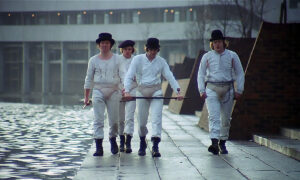The Renaissance in Italy came from its cities, and not by accident. What we now call “agglomeration effects” were at work here. Within their curtain walls, all classes and factions were crammed together in lunatic proximity. Unable to grow out, these cities bristled upwards in their spires, turrets, and terraces, separated only by narrow streets.
Everything about these places lent itself to a faster pace of life. These were hothouse conditions for, among other things, treason, conspiracy, republican asabiyyah, artistic experiments, scientific experiments, murder, usurpation.
Yet to a certain kind of urbanist and architect in 2020s Britain, the salient feature of the cities of the Italian Renaissance is that they were walkable. Saying no to the tyranny of the vehicle, the citizens of these places opted instead for interwoven quilts of local and communal belonging. Milan under the iron rule of the insane torturer and patron of the arts Galaezzo Sforza was in fact a “15-minute city” of human-scaled vernacular buildings and pedestrianised Great British high streets. Shops, housing, employment, open spaces: all sat happily within walkable and cyclable distance.
But to the extent that these cities really were walkable, this was a product, not of choice, but of necessity. They were under constant siege and so had to be corseted by walls — living nose-to-nose was more a matter of civic defence than anything else. Not that they would even need to spread much further out: Florence in 1400, mistress of cities, was roughly the size of modern-day Weymouth.
And anyway, would a Renaissance prince really have turned their nose up at a car, if they had existed? Cesare Borgia would probably have allowed cars into buildings. And whatever the virtues of vibrant close-knit townscapes, most condottieri tried to escape them as soon as possible, raising a palace on Lake Como or a monolith fortress attached to the city walls.
That the city states of Italy might ever be identified with settled torpor is the result of a longstanding intellectual current in English life. This is young fogeyism — the conservatism of the literate middle classes which, for one reason or another, is estranged from those forces that made Britain a modern country: the Reformation, industrialisation, and parliamentary supremacy.
In many cases, this was more of a personal effect. Towards the end of the last century nothing was more common than a tweedy journalist who felt the dissolution of the monasteries like a wound, but baulked at, say, Norman Tebbit.
But this kind of showboating belied a number of sincere beliefs and assumptions that have since been incredibly influential. Chief among them is the idea that what traditional European society really meant was strong community bonds, particularly at a local and rural level. This means that anything that might disturb this idyll — like Bolshevism, fascism, urbanisation, Thatcherism, or the break with Rome — is simply part of a generalised “modernity” that can be dismissed in toto. For fogeys this is the omnicause that effaces all others. Confronted with a transcendent evil like this, many would retreat into the quietism of architecture and antiques.
Young fogeyism, this cast of mind, endures to this day. If anything, it has become more influential. For one, its modern adherents are all business. People like Auberon Waugh and Peregrine Worsthorne were sustained by journalism, but in the 2010s and 2020s tweed and flat caps are now more commonly found in think tanks, the Spad-ocracy, architectural practice, and strategic comms. Modern young fogeys are active and driven; unlike the earlier generation, who had no real use for books or ideas, except for those found in novels, today’s young fogeys have a worked-out theoretical justification for their beliefs — drawn from Roger Scruton, Edmund Burke, and the table talk of Charles III.
And here we find the same opposition to anything that might act as a solvent to Community. For the new young fogeys, this is the car. In the output of the think tank and urban design consultancy Create Streets, one of the main young fogey outfits, the car takes on an almost demonic aspect — shrieking down “dual carriageways” at breakneck speeds, leaving small children “sheltering timidly at home”. For the young fogeys of the 2020s, the car is nothing less than the Revolution on wheels: breaking up social bonds, reconfiguring the towns and cities in their image, destroying Britain’s stock of Georgian and Victorian buildings, and causing — that old chestnut — atomisation.
This is more than idle talk. Keir Starmer, like Michael Gove before him, has announced plans for the mass construction of Victorian mansion blocks and Georgian terraces as the solution to Britain’s housing shortage. And by a strange turn of the wheel, this new generation of fogeys has now been given something like a carte blanche over these plans: it is now the politicians that approach the fogeys, not the other way round. Labour Together and Onward, two think tanks of the main parties, both appeared at Create Streets’ “Restitched” urban design conference in March.
This was no small feat, and these people should be congratulated on their achievement. Through a mix of royal patronage, dogged activism and a small group of devoted practices, the young fogey’s vision of urban life has emerged from the long years of obscurity and ridicule to win a final victory in the “style wars” of British architecture, which began with John Betjeman’s rescue of St Pancras station in 1967. Georgian, Edwardian, Victorian, and other vernacular styles now outpoll all others among the public.
To an extent, theirs was a victory by default. Other solutions to the problem of housing, like help-to-buy, or Gordon Brown’s eco-towns, had all run to nothing or made things worse; and proposed reforms to the planning permissions system collapsed at the Chesham and Amersham by-election of 2021. Young fogeyism in architecture was the only organised force left standing, and so now Britain’s new housing will be built on the pattern of Charles III’s Poundbury: as walkable garden suburbs of pedestrianised lanes, piazzas, trams, and gently dense traditional buildings.
The ambitions of groups like Create Streets are grand. They hope to recreate the beloved urban villages of London, only on a wider scale, and in so doing “restitch” a frayed social fabric. This is not to be discounted. These people have thought seriously and conscientiously about the problems at hand and have offered a number of valuable solutions.
But this project will, at the end of the day, be carried out according to the worst prejudices of the young fogeys: the awe for community in the abstract; the anti-modernism; the historical claptraps about traditional life. These will ensure that, in practice, little of Marylebone, Hampstead, or Dulwich will be recreated at all. They will, more than anything else, make these young fogeys the willing catspaws of some of the most retrograde forces in English society.
There are three reasons for this. The first: that the young fogeys often evince little sympathy for the people who will live in these new districts. They are, in the main, small traders, and professionals — often with families — who have been priced out of urban centres. For these people, the car is simply a fact of life. Small traders need to move goods and equipment, and white-collar workers have to commute to the centre of town. Things like commuter rail are often thin on the ground and unlikely to expand anytime soon, and, in any case, are of little use to an electrician who needs to transport their kit.
This is the material reality for millions of people, but all too often the young fogeys can only answer this with scorn. Cars are agents of vulgar modernity, you see: they require infrastructure that is manifestly not “human-scaled”, and the constant movement that they enable is an affront to ideas of local community and belonging. Other than this, these would-be planners can now simply fob people off with the climate (Did you know that “Conservation” is actually the most important type of “Conservatism”?).
All this has made young fogeys into some of the premier apologists — Create Streets is an honourable exception in this regard — for genuinely obnoxious measures like low traffic neighbourhoods (LTNs) and Ulez, things which really do make life harder and more expensive for the middle and working classes. One such scheme piloted by Lambeth Council caused local bus journeys of less than three miles to take over two hours.
And so, under the fogeys’ direction, Britain’s new garden districts will likely use all kinds of baroque devices to inconvenience cars and those who drive them as much as possible. Sensing trouble, a recent report from Create Streets titled Move Free urged their more fire-eating colleagues in local government and urban design not to “wage a war against motorists”. It has even argued that “15-minute cities” need not necessarily mean restrictions on transport. But having conceded the principle that a person’s right to go where they please is less important than communal and climate solidarity, it’s difficult to see how these things could ever be separable in practice.
What’s more, it’s nonsense to suppose that things like walking, cycling, and public transport are somehow more in communion with traditional patterns of life. For the original owners of the Georgian terraces that are now to be aped, the main way of getting around was the carriage or the horse: in other words, an individualist if not aristocratic form of transport in which free movement was taken for granted. Most townhouses from this era came equipped with an outside scraper to wipe off muddy riding boots. Which, then, is more in keeping with the society that produced these buildings in the first place: the car or the bollarded sham piazza?
Second is the determination to turn every urban environment into a sort of market square. One shibboleth of urban planning is that demand rises to meet supply, and so constructing new road capacity for cars is self-defeating. This is not an insight that is ever applied to pedestrians. By assigning large stretches of these new neighbourhoods exclusively to walkers, the young fogeys will simply encourage more foot congestion, which can be just as bad as traffic.
Walkability for its own sake is the fastest way to kill a real place and turn it into an extended playground for who knows what. By turning the surrounding area into a permanent mandatory funzone it has ruined the Southbank Centre, just as it will surely ruin Soho if the demands to de-car it are ever met. Pedestrianisation is well underway in the City of London, and if left unchecked it will transform what is a stately place of business into the same theme-park melange.
Again, this has nothing to do with old-school ways of living, and it will do nothing to recreate, say, the gentle society of garden squares in places like Marylebone and Chelsea. These societies, these places, all recognised the need for exclusive areas of quiet and seclusion from the wider world — in other words, the willingness to tell people to get lost. Too often, “human-scaled” development turns out simply to mean teeming humanity everywhere, at all hours, and from which there is no privacy: once again, young fogeyism as applied here succeeds only in recreating what could often be so dreadful about traditional societies.
Third and last is the devotion to Community with a capital C. What this leaves out is what was perhaps the most important feature of traditional urban life: exclusivity and discrimination. Residents of 15th-century Florence or Edwardian London enjoyed a freedom of association and disassociation that would be unthinkable to us today. Community with your fellow creatures was almost entirely voluntary, and it was one of the main reasons why civilised living in these compact conditions was possible.
This is not what’s on offer here. Local community is not a good thing in and of itself, and it will do little to repair any social fabric in these new garden suburbs. In many cases it will do the opposite. These new developments will include requirements for affordable and council housing, the latter of which, we are reminded, does not distinguish between citizens and non-citizens. People will resist housebuilding if they come to see it as a proxy for immigration, and they will in fact resent being “restitched” to the things that they moved out to the burbs to disassociate from. In this context, gentle density and the emphasis on community spaces would sharpen these problems in a way that divided and car-centric Metroland would not.
Young fogeyism shows little appreciation for these questions, seeing in this blatant social engineering only the best philanthropic traditions of the Church of England. If a lack of community is bad, then artificial and forced community is worse. What really did it for the civilisation of the mansion blocks and the Georgian terraces was not cars, but the “New Jerusalem” — that everyone was to now live together in a shared community in which all distinctions were effaced.
In the face of these Ruritanias, who is truly advancing the cause of urban living in Britain today? That honour belongs to one group and one group only: the assorted part-time yoga instructors, small tradesmen, and consultant astrologists who combine to overthrow LTNs, or else burn, melt, and pull down Ulez cameras. These people’s cause is the cause of modernity: that Britain’s cities really should be integrated economic zones free of fines, customs barriers or restrictions on free travel. They, and the small traders and suburban transplants that they act for, will see in the proposals of the young fogeys only another attempt to constrain and reduce them.
Many will also notice a strange combination: traditional aesthetics, paired with all the stuff of Clarksonian nightmare. In people like Charles III, and indeed even in Keir Starmer, the two are already well combined. Future generations may wonder why we ever made the distinction.
Disclaimer
Some of the posts we share are controversial and we do not necessarily agree with them in the whole extend. Sometimes we agree with the content or part of it but we do not agree with the narration or language. Nevertheless we find them somehow interesting, valuable and/or informative or we share them, because we strongly believe in freedom of speech, free press and journalism. We strongly encourage you to have a critical approach to all the content, do your own research and analysis to build your own opinion.
We would be glad to have your feedback.
Source: UnHerd Read the original article here: https://unherd.com/





